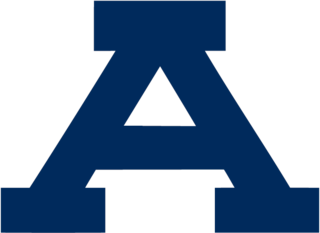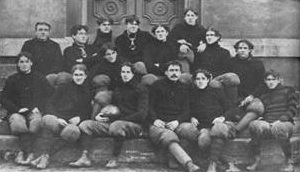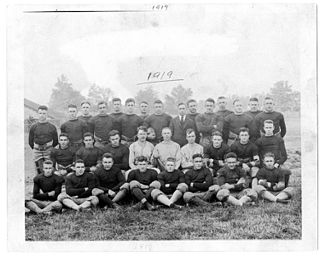Related Research Articles

The 1908 Auburn Tigers football team represented Auburn University in the 1908 Southern Intercollegiate Athletic Association football season. The team went 6–1, outscoring opponents 158–10. Auburn featured a strong defense that held all but one opponent scoreless. The team was the first during the second term of coach Mike Donahue at Auburn.

The 1917 Auburn Tigers football team represented Auburn University in the 1917 Southern Intercollegiate Athletic Association football season. It was the Tigers' 26th season and they competed as a member of the Southern Intercollegiate Athletic Association (SIAA). The team was led by head coach Mike Donahue, in his 13th year, and played their home games at Drake Field in Auburn, Alabama. They finished with a record of six wins, two losses and one tie.

The 1919 Auburn Tigers football team represented Auburn University in the 1919 college football season. It was the Tigers' 28th overall season and they competed as a member of the Southern Intercollegiate Athletic Association (SIAA). The team was led by head coach Mike Donahue, in his 15th year, and played their home games at Drake Field in Auburn, Alabama. They finished with a record of eight wins and one loss and as SIAA champions.

The 1895 Georgia Bulldogs football team represented the University of Georgia during the 1895 Southern Intercollegiate Athletic Association football season. The Bulldogs competed as a member of the Southern Intercollegiate Athletic Association (SIAA) and completed the season with a 3–4 record, Georgia's first losing season. Georgia lost twice to North Carolina, and played Alabama for the first time.

The 1908 LSU Tigers football team represented the LSU Tigers of Louisiana State University during the 1908 college football season. The Tigers were coached by Edgar Wingard and posted a perfect 10–0 record, outscoring opponents 442 to 11. The team played its home games at State Field and competed as members of the Southern Intercollegiate Athletic Association (SIAA).

The 1909 LSU Tigers football team represented the LSU Tigers of Louisiana State University during the 1909 college football season. The LSU team posted a 6–2 record, losing to Southern Intercollegiate Athletic Association (SIAA) champion Sewanee and to an undefeated Arkansas. Notable victories include those over Mississippi and Alabama.

The 1921 Florida Gators football team represented the University of Florida in the 1921 college football season. It marked the Florida Gators' 15th overall season, and its 9th and final as a member of the Southern Intercollegiate Athletic Association (SIAA). The Gators played their home games at Fleming Field in Gainesville, Florida. It was head coach William Kline's second season leading the Gators' football team. They finished the season with a record of 6 wins, 3 losses, and 2 ties, finishing sixth in conference play.
The 1916 Tennessee Volunteers football team represented the University of Tennessee in the 1916 Southern Intercollegiate Athletic Association football season. John R. Bender served his first season as head coach of the Volunteers. Because of World War I, Tennessee did not field another varsity squad until 1919.

The 1904 Vanderbilt Commodores football team represented Vanderbilt University during the 1904 Southern Intercollegiate Athletic Association football season. The team's head coach was Dan McGugin, who served his first season in that capacity. Members of the Southern Intercollegiate Athletic Association, the Commodores played six home games in Nashville, Tennessee and finished the season with a record of 9–0.

The 1915 Vanderbilt Commodores football team represented Vanderbilt University during the 1915 Southern Intercollegiate Athletic Association football season. Dan McGugin served his 12th season as the Commodores' head coach. Vanderbilt was a member of the SIAA. They faced a 10-game schedule. Vanderbilt scored 459 points in its first seven shutout games, and 514 points in 510 minutes of actual playing time by season's end, making it a legitimate "point-a-minute team" leading the nation in scoring with a school record still unequaled today.

The 1902 Clemson Tigers football team represented Clemson Agricultural College—now known as Clemson University—during the 1902 Southern Intercollegiate Athletic Association football season. Under third year head coach John Heisman, the Tigers posted a 6–1 record, including an undefeated Southern Intercollegiate Athletic Association record, and thus a conference championship. The lone loss was to rival South Carolina, in a controversial game ending in riots and banning the contest until 1909.

The 1903 Clemson Tigers football team represented Clemson Agricultural College—now known as Clemson University—as a member of the Southern Intercollegiate Athletic Association (SIAA) during the 1903 college football season. Led by John Heisman in his fourth and final season as head coach, the Tigers compiled an overall record of 4–1–1 with mark of 2–0–1 in SIAA play.
The 1907 Vanderbilt Commodores football team represented Vanderbilt University during the 1907 Southern Intercollegiate Athletic Association football season. The team's head coach was Dan McGugin, who served his fourth season in that capacity. Members of the Southern Intercollegiate Athletic Association, the Commodores played five home games in Nashville, Tennessee and finished the season with a record 5–1–1 and 3–0 in SIAA.

The 1902 Vanderbilt Commodores football team represented Vanderbilt University during the 1902 Southern Intercollegiate Athletic Association football season. W. H. Watkins was in his second year coaching Vanderbilt. Vanderbilt was playing in its 13th season of football. The Commodores had wins over Cumberland, Ole Miss, Central of Kentucky, Tennessee, Washington University, Kentucky, Tulane and LSU. The Tulane and LSU contests were played with one day's rest between games for the Commodores.
The 1910 Vanderbilt Commodores football team represented Vanderbilt University in the sport of American football during 1910 college football season. In Dan McGugin's 7th year as head coach, the Commodores as members of the Southern Intercollegiate Athletic Association (SIAA) compiled an 8–0–1 record and outscored their opponents 165 to 8, winning a conference championship.

The 1916 Georgia Tech Yellow Jackets football team represented the Georgia Tech Golden Tornado of the Georgia Institute of Technology during the 1916 Southern Intercollegiate Athletic Association football season. Georgia Tech was a member of the Southern Intercollegiate Athletic Association (SIAA). The Tornado was coached by John Heisman in his 13th year as head coach, compiling a record of 8–0–1 and outscoring their opponents 421 to 20. Georgia Tech played its home games at Grant Field. One writer claimed the 1916 team "seemed to personify Heisman." This was the first team to vault Georgia Tech to national prominence.

The 1909 Sewanee Tigers football team represented Sewanee: The University of the South during the 1909 Southern Intercollegiate Athletic Association football season. The team was coached by Harris G. Cope in his 1st year as head coach, compiling a record of 6–1 and outscoring opponents 160 to 42 to win the Southern Intercollegiate Athletic Association title. Sewanee beat the previous season's champions LSU and Auburn, and upset rival Vanderbilt, handing the school its first loss to a Southern team in six years.

The 1903 Cumberland Bulldogs football team represented Cumberland University in the 1903 college football season. The team was a member of the Southern Intercollegiate Athletic Association (SIAA), compiling a 6–1–1 record. The Bulldogs notably beat Vanderbilt and tied John Heisman's Clemson at year's end in a game billed as the "SIAA Championship Game." They also beat Alabama, LSU, and Tulane in five days. The school claims a share of the SIAA title. It has been called "the best football team in the history of Cumberland."

The 1915 Georgia Tech Yellow Jackets football team represented the Georgia Tech Golden Tornado of the Georgia Institute of Technology during the 1915 college football season. The Tornado was coached by John Heisman in his 12th year as head coach, compiling a record of 7–0–1 and outscoring opponents 233 to 24. Georgia Tech played its home games at Grant Field. The Tech team claims a Southern championship, and had what was then the greatest season in its history.

The 1919 Georgia Tech Golden Tornado football team represented the Georgia Tech Golden Tornado of the Georgia Institute of Technology during the 1919 Southern Intercollegiate Athletic Association football season. The Tornado was coached by John Heisman in his 15th year as head coach, compiling a record of 7–3 and outscoring opponents 257 to 33.
References
- ↑ "2017 LSU Tigers Media Guide" (PDF). Louisiana State Athletics. p. 107. Retrieved April 27, 2018.
- ↑ "University of Tennessee defeats King College". The Journal and Tribune. October 12, 1902. Retrieved August 1, 2021– via Newspapers.com.
- ↑ "Maryville defeated by U, of T. football team by score of 34 to 0". The Journal and Tribune. October 19, 1902. Retrieved August 1, 2021– via Newspapers.com.
- ↑ "Vanderbilt wins, University of Tennessee defeated at Knoxville by Commodores". Nashville Banner. October 27, 1902. Retrieved August 1, 2021– via Newspapers.com.
- 1 2 "U. of T. team defeats the boys from Sewanee". The Journal and Tribune. November 2, 1902. Retrieved August 1, 2021– via Newspapers.com.
- 1 2 "Tennessee wins, scores touchdown and goal from field". Nashville Banner. November 8, 1902. Retrieved August 1, 2021– via Newspapers.com.
- 1 2 "Tennessee-Mississippi, U. T. boys win the game at Memphis by a score of 11 to 10". The Journal and Tribune. November 16, 1902. Retrieved August 1, 2021– via Newspapers.com.
- 1 2 3 "Techs beaten in hard battle". The Atlanta Constitution. November 23, 1902. Retrieved August 1, 2021– via Newspapers.com.
- ↑ "Hard fought battle; Clemson won game". The Knoxville Sentinel. November 28, 1902. Retrieved August 1, 2021– via Newspapers.com.
- 1 2 "Volunteers Lose To Commodores". Atlanta Constitution. October 26, 1902. p. 5. Retrieved March 29, 2015– via Newspapers.com.

- ↑ Wiley Lee Umphlett (1992). Creating the Big Game: John W. Heisman and the Invention of American Football. pp. 64–65. ISBN 9780313284045.
- ↑ "Records" (PDF). p. 324. Archived from the original (PDF) on March 4, 2016.
- ↑ "Prodigious Kick". Schenectady Gazette. October 10, 1934. Retrieved January 12, 2025– via Google News.
- ↑ John M. Heisman. Heisman: The Man Behind the Trophy. pp. 104–105.
- ↑ "From Southeastern College Teams The Constitution Selects An Eleven". Atlanta Constitution. December 1, 1902.